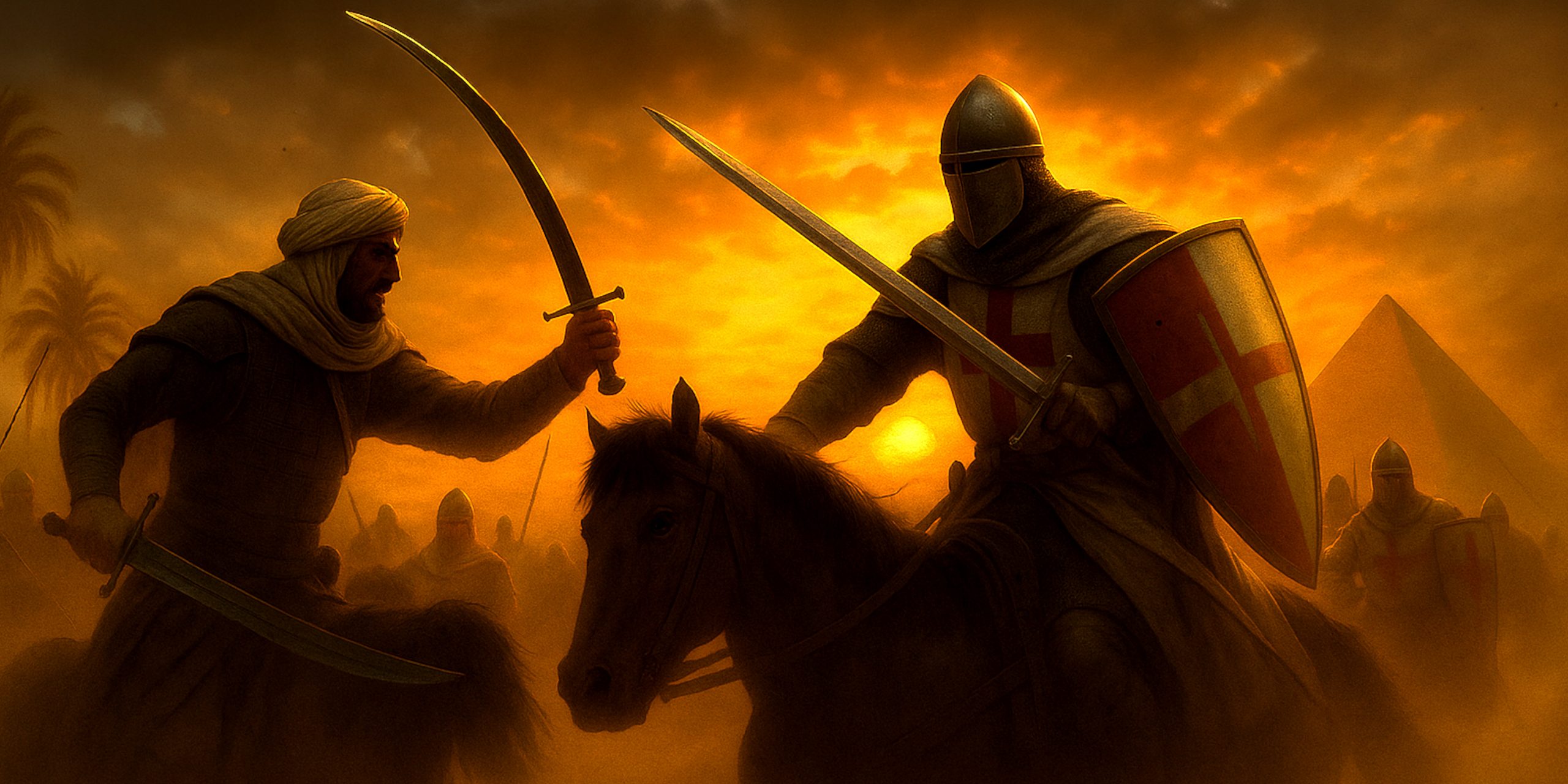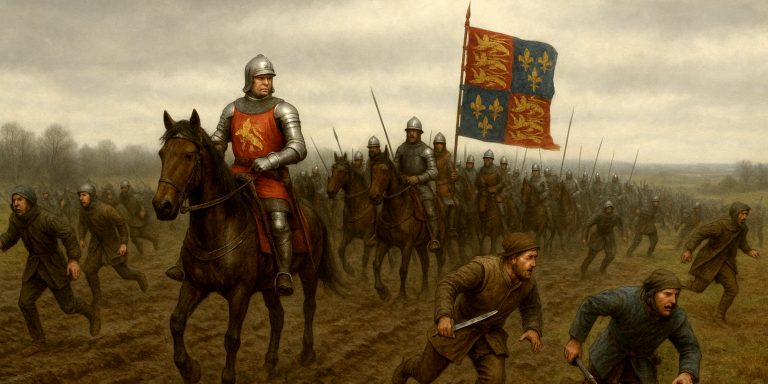
The Battle of al-Babein, fought in March 1167 near Giza, marked one of the earliest tests of Saladin’s leadership under his uncle, Shirkuh. It was not a grand clash of empires, but a complex tangle of Egyptian politics, Crusader opportunism, and the slow but relentless rise of the Ayyubid dynasty. The fight unfolded in the dusty plains between the forces of the Zengids, the Crusader Kingdom of Jerusalem, and the tottering Fatimid Caliphate, who seemed to change sides more often than a medieval minstrel changes verses.
This was the battle where the young Saladin began to show the poise and patience that would later make him a legend.
Background
By the mid-12th century, Egypt was a crumbling prize. The Fatimid Caliphate was decaying from within, its court divided by intrigue and its treasury strained. Both Nur ad-Din of Syria and King Amalric I of Jerusalem coveted it. Nur ad-Din sent his trusted general Shirkuh south with a small but hardened army. Alongside him rode his nephew, Yusuf ibn Ayyub, better known as Saladin.
The Fatimids, in desperation, sought help from the Crusaders. Thus, Amalric entered Egypt as their “protector”, a diplomatic phrase meaning “temporary thief.” The two armies met near al-Babein, not far from the Nile floodplain, in a confused and uneven engagement.
Forces
| Side | Commander(s) | Estimated Strength | Composition |
|---|---|---|---|
| Zengid/Ayyubid Army | Shirkuh ibn Shadhi, Saladin | c. 2,000–3,000 | Syrian cavalry, Kurdish light horse, some Armenian mercenaries |
| Crusader-Fatimid Alliance | King Amalric I of Jerusalem, Shawar (Fatimid vizier) | c. 10,000–12,000 | Frankish heavy cavalry, Egyptian infantry, Nubian archers, Bedouin scouts |
Saladin’s troops were vastly outnumbered, though more disciplined. Amalric relied on the heavy impact of his Frankish knights and the local Fatimid troops for numbers.
Arms and Armour
Zengid-Ayyubid Forces
- Swords: Predominantly curved saif blades, early forms of the later Mamluk sabre, with broad single-edged curvature suitable for cavalry slashing.
- Armour: Lamellar cuirasses, mail hauberks of Syrian ironwork, and circular leather shields reinforced with bronze studs.
- Other Weapons: Composite bows of horn and sinew, short lances, and the tabarzin (light axe) among Kurdish cavalry.
Crusader-Fatimid Forces
- Swords: Frankish knights wielded arming swords of Oakeshott Type XII, straight and double-edged, optimised for thrust and cut.
- Armour: Chainmail hauberks with coifs and chausses, conical nasal helms. Fatimid soldiers wore lighter quilted armour or leather scale.
- Other Weapons: Long lances for shock charge, crossbows, Egyptian spears, and scimitars among Muslim contingents.
The clash, therefore, was as much a duel between two martial traditions as between armies, swift eastern manoeuvre against ironclad western mass.
Course of the Battle
Timeline
| Phase | Event | Notes |
|---|---|---|
| Morning | Shirkuh divides his smaller army into three wings | A risky move meant to outflank the heavier Crusader line |
| Midday | Saladin leads a feigned retreat on the right flank | Crusader cavalry pursue too far, breaking formation |
| Afternoon | Shirkuh counterattacks the disordered enemy centre | The Syrian horsemen regain ground briefly |
| Evening | Both sides withdraw after indecisive fighting | Heat, exhaustion, and confusion end the day |
Saladin’s controlled withdrawal demonstrated a maturity unusual for his age. Amalric’s men suffered from the Egyptian heat and the dust that hung over the battlefield like a curse. The result was tactically inconclusive, but strategically it shifted Egyptian confidence away from the Crusaders. Within a year, Shirkuh and Saladin would be masters of Cairo.
Contemporary Accounts
The historian Ibn al-Athir wrote:
“At al-Babein, Saladin showed prudence and command far beyond his years. Though fortune did not yet favour him, his star was rising, and men began to speak his name with respect.”
William of Tyre, never one to give Muslim generals too much credit, grudgingly observed:
“The Turks fought with cunning and patience, and though our king was valiant, the day was not ours.”
Even the Fatimid chroniclers noted the shifting winds, recording that “the Syrians fought as if possessed, and the Franks withdrew in disarray.”
Archaeology
The battlefield near al-Babein has never been thoroughly excavated, partly due to modern development around Giza and partly because the Nile has altered the terrain beyond recognition. However, scattered finds of arrowheads, fragments of chainmail, and traces of horse trappings have been reported in the region.
One particularly intriguing find was a corroded sabre hilt with an engraved Qur’anic verse, possibly of the same type wielded by Kurdish cavalry. While direct attribution is impossible, its discovery reinforces accounts of light, mobile horsemen harassing Crusader flanks.
Modern archaeologists have also identified possible encampment mounds matching 12th-century Syrian military structures, though the evidence remains circumstantial.
Legacy
The Battle of al-Babein was a learning ground for Saladin rather than a crowning triumph. It was here that he began shaping the tactical blend of mobility, restraint, and psychological warfare that would later define his campaigns.
For Amalric, the engagement was the beginning of frustration in Egypt. His alliance with the Fatimids eroded quickly, and within four years the Crusaders were expelled from the Nile altogether.
From the perspective of medieval strategy, al-Babein sits somewhere between a stalemate and a rehearsal for greatness. It proved that the Crusader heavy charge, formidable as it was, could be blunted by flexible command and patience, a lesson Saladin would repeat with devastating effect twenty years later at Hattin.



